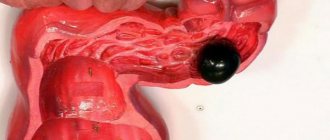Stomach tumors are not always malignant. At the same time, the presence of a benign formation also carries its own risks. For this reason, it is important to know for what reasons they are formed, how they manifest themselves and what to do when they are identified. This will help prevent degeneration into a malignant tumor in the future. Tubular adenoma of the stomach is quite common. This is a polypoid formation formed from altered epithelial cells. If the formation is less than one centimeter in size, the risks of its malignancy are minimal. If the formation is larger, there is always a risk of cancer formation, so the pathology should be treated immediately after detection.
Tubular adenoma of the stomach is a polyp-like neoplasm
Reasons for education
As with malignant tumors, the exact cause of adenomas is unknown. Provoking factors, according to scientists, may be:
- excessive consumption of animal fats;
- lack of fiber;
- excess toxins;
- bad habits;
- chronic inflammatory processes.
Insufficient fiber in food causes the development of tubular adenoma
Pathology can develop in everyone without exception, even in children. According to statistics, patients over 60 years of age have a greater risk of developing polyps.
It is characteristic that polyps increase as the patient grows older and can reach three centimeters.
The form of education also differs. They can have a leg or be without one, long and thin or thick but short. There is a possibility of torsion of the leg and, as a result, tissue necrosis. This leads to bleeding and severe inflammation. In most cases, single formations occur. They are round in shape, smooth, and there are no areas of ulceration. The mucous membrane covering the formations is usually not changed. If there are polypous growths, then the formations in such a situation are often small, the mucous membrane is also not changed.
Pedunculated polyps may form in the stomach
Gastric adenoma: tubular, papillary, tubular-villous forms
Adenomatous changes in the epithelium can be both a precancerous condition of adenocarcinoma and an indicator of an increased risk of its development. In the absence of therapy, up to 25% of polyposis undergoes slow malignancy.
Kinds
According to the WHO classification, there are several forms of mucosal lesions:
- tubular;
- papillary (villous);
- tubulopapillary.
Tubular adenoma of the stomach has clearly defined edges and a glandular structure. Tubular branches and vessels located in the upper layer of the mucosa are surrounded by atypical epithelium. The underlying tissue may remain normal or, more commonly, undergo a cystic change.
This type of polyp is the most dangerous and often turns into cancer. The most unfavorable in terms of malignancy are adenomas larger than 1–2 cm in circumference.
The papillary polyp has a velvety surface and is rarely found in its pure form. The formation can be pedunculated or have a wide base; it rarely degenerates into a malignant form.
Tubular villous adenoma is a combination of tubular and papillary structures, each of which occupies at least 30% of the total tumor volume. Further growth of the epithelium leads to an increase in the number of villi, which can be located both on the surface of the formation and inside the glandular cavities.
Causes
Atrophic gastritis is recognized as one of the main causes of gastric adenoma, especially if it is complicated by unfavorable conditions. Another, no less common culprit of polyposis is hereditary predisposition.
The following factors can provoke pathological proliferation of the epithelium:
- unhealthy diet (irregular meals, inclusion of “aggressive” foods in the diet);
- poor environmental conditions;
- decreased immunity;
- uncontrolled use of medications;
- the presence of the bacterium Helicobacter pylori in the gastrointestinal tract;
- age after 40 years.
A viral infection of the gastric mucosa, drinking alcohol and smoking, and frequent stress can serve as an impetus for the development of adenoma.
Diagnostics
Today, the diagnosis of gastric adenoma has made significant progress and makes it possible to identify polyps up to 0.5 cm in size, determine their type and exact quantity.
Although a reliable diagnosis can only be made with the help of a biopsy and endoscopy, the patient is prescribed a number of additional studies that help determine the patient’s general condition and the degree of damage to the mucosa:
- clinical blood test with test for Helicobacter pylori;
- Ultrasound;
- CT;
- contrast radiography.
During the diagnostic process, adenomatous polyposis must be differentiated from carcinoma, gastritis and various types of hyperplasia.
Treatment
Adenoma in all cases is subject to surgical removal. Drug therapy is not only ineffective, but can also waste valuable time. The use of medications is justified only if the pathology has developed against the background of gastritis - with their help, the symptoms of inflammation of the mucous membrane are eliminated.
To remove the adenoma, endoscopic polypectomy or gastrectomy is used. The first method is the most gentle and less traumatic. It is prescribed for single small polyps. After 1.5–2 months, the operated tissues are completely restored, and after 11–12 weeks the patient undergoes a repeat endoscopy to ensure that there is no adenoma.
Sometimes the oncologist takes a wait-and-see approach, taking the patient under observation. The patient is prescribed a strict diet, adherence to a lifestyle and nutritional regimen, perhaps a change of job and medical observation. When gastric adenoma becomes active, the question of surgery arises.
Prevention
Specific prevention designed to protect a person from the appearance of a tumor has not been developed. Prevention of pathology is usually based on measures to prevent and treat gastritis, as well as other inflammatory diseases of the gastric mucosa.
The main ways to prevent gastrointestinal adenomas:
- adherence to diet;
- refusal of excessively hot, spicy and irritating foods, preservatives;
- taking medications only as prescribed by a doctor;
- eliminating stress and fatigue.
To maintain immunity, it is very important to lead an active lifestyle, wisely alternate between exercise and rest, and not get carried away with alcohol. All these measures taken together will help to avoid the appearance of a tumor or, if trouble has already happened, to slow down its growth.
Gastric adenoma is a conditionally benign tumor, that is, with timely and competent surgical therapy, it is completely curable. Therefore, at the slightest suspicion of pathology, it is necessary to consult a specialist, and not engage in amateur activities.
Elena Medvedeva, doctor, specially for Zhkt.ru
about stomach polyps
Source: https://zhkt.ru/zheludok/adenoma.html
Pathology Clinic
The whole danger of the pathology lies in the fact that villous adenoma does not cause any clinical manifestations. In most cases, it is detected during diagnostic procedures for another pathology. A polyp can grow and develop for a long time without causing any discomfort to the patient. Only if complications develop can bleeding occur. They manifest themselves in the form of blood streaks in the stool or vomit.
It is important to note that vomiting is not a characteristic symptom of the pathology and more often appears as a sign of another disease that accompanies tubular adenoma, for example, gastritis.
The functions of the stomach are not affected by adenoma. There is no pain. The appearance of blood streaks in the stool forces patients to undergo a full examination, during which the deviation is determined. Only in extremely rare cases, when polyps grow, complaints such as a feeling of heaviness, nausea, appetite disturbances, and so on may occur.
Tubular adenoma in rare cases causes loss of appetite
Symptoms
Gastric adenoma is often asymptomatic and becomes an “accidental” finding during endoscopic examination of the gastrointestinal tract. Since neoplasms are formed predominantly against the background of atrophic gastritis (less often they are associated with other gastric pathologies), the patient will experience a clinical picture characteristic of this disease:
- decreased appetite;
- belching;
- heartburn;
- nausea;
- vomiting after eating rough, “heavy”, fatty, spicy food;
- discomfort, heaviness and pain in the epigastric region;
- a feeling of fullness in the stomach, even after eating a small portion of food.
When polyps grow and their size increases to 2 cm or more, the following symptoms of pathology may appear:
- Constant aching pain in the stomach, depending on food intake, associated with the presence of inflammation in the mucous membranes of the gastrointestinal tract.
- Signs of internal bleeding that occur when the adenoma is damaged or ulcerated (tarry stools, vomiting blood, anemia).
- Symptoms associated with chronic blood loss are weight loss, fatigue, loss of strength, fatigue, dizziness, tachycardia, etc.
An adenomatous polyp of the stomach can transform into adenocarcinoma at any time. As a rule, when a tumor becomes malignant, a person’s condition worsens.
Adenomas can lead to the development of serious complications. When the pedicle feeding the polyp is twisted, vascular thrombosis and tissue necrosis occur. The patient develops intense pain in the stomach, body temperature rises and other signs of intoxication of the body are also added. If an adenomatous formation is infringed, the movement of food through the digestive tract stops and sharp cramping pain appears in the epigastric region. Both conditions require emergency medical attention.
Diagnosis of pathology
Before starting treatment, it is important to accurately determine the type of disease. For this purpose, radiography using a contrast agent is prescribed. In this case, you can use both a suspension injected into the stomach cavity to assess the contours of the organ walls, and intravenously administered drugs. The latter method helps to exclude the malignancy of a process characterized by an excessive network of blood vessels.
FGDS is also mandatory. During the manipulation, a thorough examination of the mucous membrane and formation is performed. The condition of neighboring organs is also assessed. Ultrasound, CT, and biological fluid tests can be used as additional techniques. Only after this are the results assessed and conclusions drawn.
If the formation is less than one centimeter, a wait-and-see approach may be chosen. In other cases, the decision depends on the age of the patient, hereditary factors, the state of the body as a whole, and so on.
Gastric adenoma can be diagnosed using ultrasound
Symptomatic picture of adenoma
With tubular adenoma of the rectum, there may not be any symptoms for a long time. And the person does not even suspect that he is sick. But sooner or later, signs of dysplasia (cell proliferation) appear. The main ones are considered to be:
:
- blood and mucus in the stool;
- constipation and diarrhea;
- discomfort in the anus;
- painful acts of defecation;
- bloating, gases in the intestines.
Adenoma is characterized by the fact that its symptoms may not appear all at once, but, for example, only one or two of them. And, since they are characteristic of many other diseases, a person does not even suspect the presence of a tumor, attributing the manifestations to a common disorder or other ordinary ailment. This is the main insidiousness of tubular adenoma, which is far from being as harmless as it might seem.
Differential diagnosis
Making a diagnosis is an important stage, but in addition to this, you should remember that a considerable number of diseases occur with the same clinical picture as, for example, polyps. Therefore, differential diagnosis should not be ignored. Quite often, formations in the stomach occur in parallel with intestinal damage. For this reason, it is recommended to perform sigmoidoscopy to exclude the presence of polyps in the intestines.
Also, during the examination of the patient, it is important to exclude such abnormalities as ulcers, cancer and other stomach lesions that can cause similar symptoms. At the same time, it is important to perform all manipulations as accurately as possible, including preparation for their implementation, since the slightest violations in the technique can lead to false results.
Types of adenomas that can occur in the intestines
Intestinal adenomas often cause colorectal cancer.
Based on the nature of germination and external signs, polyps are divided into:
- villous formations;
- tubular tumors;
- serrated adenomas;
- mixed neoplasms.
Villous.
It is the villous tumor of the colon that doctors call the most dangerous. This is due to the fact that in 40% of cases it degenerates into cancer.
Its features include:
- softness of structure;
- numerous formations that spread over the entire surface of the intestine;
- can grow up to 10 cm in diameter;
- velvety surface with villi, looks like a cauliflower inflorescence;
- has a wide base that can rise 30 mm above the surface of the mucous membrane.
This adenoma is also called villous and consists of fibrous villi, which look like a wide rod and are covered with columnar epithelium.
Tubular adenoma of the large intestine is called the most common.
Its signs:
- wide base;
- structure density;
- has clearly defined boundaries;
- smoothness of the tumor surface;
- has a red tint.
Basically, the identified tubular adenomas do not exceed 1 cm. Very rarely, specimens with a diameter of 3 cm or more are found. The larger the formation, the softer it is and the lobular structure it has.
This formation basically has a tubular, glandular structure, which is surrounded on different sides by loose tissue. This tumor has the most favorable prognosis for recovery.
This type of adenoma is characterized by abnormal cell division (dysplasia). The surface of the epithelium is jagged. Another name for adenoma is papillary.
Tubulo villous adenoma.
This is a mixed type of neoplasm. Tubular villous adenoma also has a name - pseudotumor. It incorporates all the characteristics that villous and tubular tumors have. They are capable of growing more than 3 cm and are very rarely small.
Doctors have not yet been able to find out the exact reasons why colon adenomas appear. It is generally accepted that this can be caused by somatic diseases associated with exposure to unfavorable external factors on the body. It is also noted that there is a hereditary predisposition to the appearance of neoplasms.
The following factors can provoke the appearance of a tubular or villous polyp of the rectum:
- Poor nutrition. Food with a high content of carcinogenic substances and a small amount of fiber can cause enormous harm to the body. This diet leads to disruption of intestinal motility and microflora.
- Environmental pollution, prolonged exposure to toxins on the body, or employment in hazardous work.
- Having bad habits.
- Frequent stress.
- Sedentary lifestyle and lack of necessary physical activity.
- Excess weight.
- Pathologies of the digestive organs.
- Heredity.
Treatment methods
Treatment of gastric adenoma is only surgical. Today, two methods are especially often used. The first is to excise the formation. The second is electrocoagulation of the polyp.
Electrocoagulation method is used to remove polyps
Important: tissues obtained during manipulation are necessarily sent for histology.
As a rule, surgical intervention using the abdominal method is used only in cases where there is a high risk of polyp malignancy. If the formation is large, it can be removed in parts. When choosing a technique, it is especially important to consider the localization of the formation. The fact is that after electrocoagulation a burn remains on the mucous membrane. If, for example, the adenoma is located in close proximity to the sphincter, the tissue is constantly in the zone of activity.
If there are no contraindications to electrocoagulation, then it is performed especially carefully. It is important to eliminate all affected tissue to prevent relapse. At the same time, it is necessary to treat tissues of only the mucous layer, since damage to deeper ones can lead to perforation and, as a consequence, to peritonitis.
After removal of polyps in the stomach, you need to undergo regular examination by a doctor.
It is especially important to try to find the cause of the polyp. This may be constant injury to the mucous membrane, an increased amount of toxins in the body, gastritis and other pathologies. Accordingly, after removal of the polyp, therapy is prescribed to eliminate the provoking factors. After treatment, the patient is registered at the dispensary and undergoes regular examinations.
Gastric adenoma: treatment, removal, nutrition, symptoms
Any pathology of the gastrointestinal tract poses a potential threat to life and health. Gastric adenoma is one of the most dangerous types of benign neoplasms, in which there is a risk of becoming a malignant tumor. Therefore, its mandatory removal is required.
There is a risk of progression to a malignant tumor.
Causes
This type of seal is formed from epithelial tissues that change. The larger the capsule, the higher the risk that its cells will transform into cancer. The reasons for the appearance of adenomatous polyp are not well understood. But the main risk factor is considered to be poor diet, which is dominated by animal fats and lacks fiber.
The following reasons can provoke the development of a neoplasm:
- foci of inflammation associated with a bacterial pathogen;
- chronic inflammatory processes, for example gastritis. The restoration of the mucous membrane occurs incorrectly, which is why tissues grow and provoke the formation of tumors; Inflammatory processes in the form of gastritis.
- Some medications increase the risk. We are talking about those drugs that negatively affect the mucous membranes. If you take them on an empty stomach, the likelihood of developing pathology increases;
- unfavorable environmental conditions and constant exposure to toxic substances. This group of reasons includes work in hazardous work, intoxication of the body, consumption of alcohol and cigarettes;
- hereditary factor. If one of the parents has been diagnosed with a disease, the likelihood that the child will experience it is very high;
- elderly age. The body of older people does not resist negative factors as effectively, so they more often suffer from neoplasms of various types.
Symptoms
In the early stages, the compaction does not irritate the lining of the gastric mucosa, so there are no obvious signs. However, later the capsule increases in size, which provokes malaise.
Common symptoms of a stomach polyp include:
Abdominal pain after eating.
- abdominal pain. It is paroxysmal or dull in nature. Depends on whether the tumor has a thin or wide stalk. The pain usually appears after a person eats spicy or fatty foods. The symptom also appears after a large amount of food eaten on an empty stomach;
- in some cases, meat intolerance occurs;
- loss of appetite and, as a result, sudden weight loss. Usually this sign appears with a significant increase in the size of the thickening. It occupies a significant part of the stomach, which is why satiety occurs faster;
- When tissue grows, the patient experiences nausea and vomiting. Sometimes blood clots are present in the vomit. In the future, gastric obstruction may occur;
- anemia develops;
- belching with an unpleasant taste and smell, as well as bloating;
- general weakness, loss of strength, sometimes dizziness and fainting. The skin becomes pale;
- If the tumor's stalk becomes twisted, internal bleeding may occur. Symptoms include tarry stools. This is a serious complication that causes a person’s death. Therefore, if a symptom appears, you should consult a doctor.
Localization
To prescribe the correct treatment, the doctor must know where exactly the adenoma is attached. It can be localized not only in the stomach, but also in the esophagus and intestines. In most cases, it forms at the entrance to the duodenum or in the antrum.
Classification of adenomas
The most common type of polyp is a solitary tubular adenoma of the stomach. However, multiple tumors also occur. They usually do not reach large sizes and are attached to the mucosa with a short base. The classification of neoplasms is based on the structural features and development of the capsules:
- Tubular adenoma of the stomach is a thickening with clearly defined boundaries. It consists of glandular tissue, which is covered by a thin layer of connective cells. Gastric obstruction develops quickly, and there is also a high probability of transformation into a cancerous tumor; It has clear boundaries.
- Villous adenoma of the stomach has a layer of connective cells that are associated with mucous and epithelial tissue; Villous.
- tubular-villous – mixed type. The capsule has villi, which are located both inside and outside the polyp. There are villi inside and outside.
The size does not depend on the type of seal. The neoplasm can increase to 2–3 cm in diameter. The higher the degree of dysplasia, the more likely the tissue becomes malignant.
Gastric carcinoma
As the size of the adenoma increases, the risk of its transformation increases. Malignant gastric carcinoma is the most dangerous complication. If cancer appears, rapid weight loss occurs, and the patient’s well-being becomes worse every day. If the pathology is not diagnosed in time, the chances of recovery will be minimal.
The higher the degree of tissue damage, the higher the likelihood of death.
Diagnostic methods
The tumor is rarely detected in the early stages because the patient does not complain of any symptoms. It is almost impossible to detect it during a routine inspection due to its small size. Therefore, most often the neoplasm is diagnosed after the symptoms appear.
During the initial examination, the doctor interviews the person to determine the exact signs. Since they are associated with other diseases, additional diagnostic procedures are prescribed:
- Contrast radiography allows you to accurately determine the presence of an adenoma. A contrast agent is injected into a vein or into the stomach, which allows the contours of the mucous membrane to be assessed. If drugs are used intravenously, this helps prevent the development of cancer. The malignant process is characterized by an increase in the number of blood vessels;
- FGDS is an effective method in which an endoscope is inserted into the stomach. You can conduct a thorough examination of the walls of the stomach and determine the exact location of the capsule, its size and features. During the procedure, additional material is taken in order to further send it for histological examination; FGDS of the stomach.
- Ultrasound or CT are used less frequently. They provide an incomplete picture of the disease;
- blood and urine tests are needed to determine the development of inflammation;
- perform a stool examination to rule out internal bleeding.
Treatment and removal
The only possible treatment for this type of adenoma is surgical removal. Medicines will not get rid of the tumor or prevent it from becoming malignant. They are prescribed only to reduce acidity levels. Today, one of two methods of surgical intervention is used. This is classic abdominal surgery and electrocoagulation.
The capsule is removed by excision of tissue.
In the first case, the procedure is performed if the polyp has significantly increased in size or there are multiple formations, gastric bleeding is present, and there is a tendency to malignancy. In the abdominal cavity, tissue is excised, through which the capsule is removed.
But more often they try to use more gentle methods. Electrocoagulation involves cauterizing the tumor. It is important that the surgeon completely removes the affected area during surgery. Otherwise, there is a risk of re-formation of the capsule.
Cauterization of the adenoma is a more gentle method.
The intervention is carried out only on the mucous membranes. If you touch deeper tissues, you can provoke disruption of the stomach, peritonitis. Internal bleeding is also possible. Therefore, this operation should only be performed by a qualified surgeon.
Electrocoagulation will not be prescribed if the tumor is attached to the gastric sphincter. The tissues there are very mobile and can be easily damaged. During the recovery period, the patient must follow a special diet. The diet should not contain dishes that will cause irritation of mucous tissues. After rehabilitation, it is necessary to visit a doctor for a routine examination. This way you can quickly detect a relapse of the disease.
In rare cases, a polyp can be removed using an endoscope. This method is used if the capsule is small.
The minimally invasive procedure is rarely used, since the pathology is practically not diagnosed in the early stages.
This is the most gentle type of intervention, since recovery takes no more than 2–3 months. In other cases, rehabilitation lasts six months, and sometimes longer.
Traditional methods
Treatment of gastric adenoma with folk remedies is ineffective because it does not get rid of the tumor. The only way to remove it is surgery.
However, traditional methods can be used after consultation with your doctor. They help reduce inflammation and stabilize the patient’s condition until surgery is performed.
Use one of the following recipes:
- mix 0.5 liters of honey, the same amount of olive oil and the juice of 2 lemons. Drink the mixture three times a day, 1 tablespoon before meals;
- Mix 10 g of propolis with 100 g of butter until smooth, melt in a water bath. Then filter and use a teaspoon once a day before meals;
- squeeze out the celandine juice and mix in equal proportions with vodka (or diluted alcohol). Let it brew for 24 hours, then take a teaspoon three times a day.
Pathology prognosis
The prognosis of the pathology depends on the treatment technique. If resection of the polyp is performed, a follow-up examination should be done after three months to assess the condition of the tissue. If the polyp begins to grow again, repeat excision is recommended. If this manipulation results in a relapse after three months, the patient is offered surgical treatment to remove part of the stomach tissue.
If treatment is started on time and the polyp is removed, there is no risk of degeneration. But you should always remember: due to the lack of precise factors leading to the appearance of formations, there is a high risk that after a certain period of time polyps will reappear in other parts of the organ. Therefore, such patients should be regularly examined by a specialist.
How to treat stomach cancer, watch the video:
Gastric adenoma: diagnosis and treatment of gastric adenoma in a European clinic
Gastric adenoma (adenomatous polyp) is a benign neoplasm of glandular epithelial cells with signs of dysplasia.
Macroscopically, it is an outgrowth of the mucous membrane on a thin stalk or on a wide base.
Microscopically, chaotic proliferation of the epithelium with numerous morphological changes (nuclear polymorphism, signs of proliferation, etc.) is determined.
Gastric adenomas are a serious pathology. The risk of their degeneration into cancer is extremely high - 40-50%. Therefore, timely detection and treatment of adenomatous formations is considered one of the priorities of modern gastroenterology.
Reasons for development
Most often, adenomatous polyps of the stomach develop due to atrophic gastritis or gastritis with low acidity. Also, any chronic diseases of the digestive system (erosions, peptic ulcers, etc.) can serve as a background for the appearance of benign tumors.
The main reasons leading to the formation of adenomas are the following:
- “invasion” of sections of intestinal epithelium into the lining of the gastric mucosa - intestinal metaplasia;
- excessive cellular proliferation against the background of chronic inflammation with subsequent hyperplasia of epithelial tissue;
- damage to the inner lining of the stomach by waste products of microorganisms Helicobacter pulori, which reduce the acidity of digestive juice and the protective properties of secreted mucus;
- systematic use of proton pump inhibitors, which, by suppressing the production of hydrochloric acid, thereby increase the production of gastrin, which stimulates cell division.
According to statistics, men get sick twice as often as women. Pathology usually develops at the age of 40-60 years. Some people have a genetic predisposition to developing benign tumors of the gastrointestinal tract. Excessive smoking, consumption of rough food and strong alcoholic drinks, and taking certain medications also contribute to the appearance of adenomas.
Classification of gastric adenoma
An adenomatous polyp can be located on any part of the organ. More often, gastric adenoma is localized in the antrum and in the pyloric region (the place of transition to the duodenum).
Gastric adenomas are divided into three groups according to histological type:
- Villous (villous, papillary) type of adenoma. It is the most favorable in terms of further prognosis. The tumor typically has a wide base and a characteristic “hairy” appearance. It consists of many villi and connective tissue elements with a small amount of glandular epithelium (no more than 25%).
- Mixed form of adenoma. It has a more pronounced degree of dysplasia compared to the previous type. The tumor contains villous and tubular structures in varying proportions. The share of papillary tissue accounts for from 25 to 75%).
- Tubular adenoma. It is the most common type. The tumor has clear boundaries, is crimson in color, and consists of epithelial glands. Under a microscope, numerous altered, branching tubes are visible, longer and wider than normal. This adenoma is characterized by slow growth and a high degree of malignancy.
Clinicians divide adenomatous polyps of the stomach into benign, transitional types and malignant (cancer).
Treatment of gastric adenoma
A diagnosed gastric adenoma requires active medical tactics, since in most cases it transforms into cancer, and here the tubular form is especially dangerous. The choice of treatment mainly depends on the histological structure and size of the tumor.
Papillary and mixed variants in some cases allow for expectant management (small size, presence of medical contraindications to surgery, etc.). If the adenomatous polyp in the stomach is not removed, the patient undergoes gastroscopy annually. If signs of malignancy, rapid tumor growth, or complications appear, the question of surgical intervention is raised.
Tubular adenomas are always subject to surgical treatment. A gastroscope is used to remove small polyps on a thin stalk that do not have signs of atypia.
A loop is placed over the mucous growth and it is removed using electrocoagulation. This method is considered less traumatic and less dangerous for the patient. The gastric mucosa recovers in 2-8 weeks.
2-3 months after surgery, a control endoscopy is performed to confirm the absence of relapse.
If the adenoma has a wide base, the tumor has a large diameter, or there are several large polyps, laparoscopic access is used.
If malignant cells are detected in the adenomatous formation, gastric resection or other radical operations can be performed, taking into account the indications and stage of the process.
Surgical interventions can also be performed using an “open” approach through an incision in the abdominal wall.
Nutrition for gastric adenoma
The diet for adenomatous polyps in the stomach is prescribed by a gastroenterologist, taking into account the background pathology (peptic ulcer, gastritis, etc.). To prevent the growth of adenomas and their recurrence after surgery, it is recommended to adhere to the following rules:
- “Heavy”, fatty, spicy and any dishes that can injure the gastric mucosa or cause irritation are excluded from the menu. The same goes for drinks.
- The consumption of “junk” food, fast food, processed foods, etc. is minimized.
- You should not overeat, it is advisable to eat in small portions in compliance with the principles of rational nutrition.
Any error in diet can aggravate the course of the disease.
Prognosis and prevention
In most cases, the prognosis for treatment will be favorable. Most often, this is typical when the adenoma is detected at an early stage, and dysplasia has not yet passed into its final form. The sooner the polyp is removed, the higher the likelihood of a complete recovery. Tubular adenoma with the most severe degree of dysplasia will almost certainly provoke the proliferation of malignant cells. In this case, the prognosis for survival depends on the success of surgery and other treatment methods.
After surgery, there is a risk of bleeding, so the patient needs to monitor his well-being. Throughout his life, he will need to visit a doctor regularly to eliminate the risk of relapse. The probability of tissue regrowth varies within 10%.
Measures to prevent this type of benign tumors include following the principles of a healthy diet. It is necessary to consume a large amount of vegetables and fruits so as not to experience a fiber deficiency. In addition, it is important not to eat large quantities of meat (especially red meat). The older a person is, the less animal protein he needs.
To reduce the risk of developing tubular tumors, lead an active lifestyle, play sports and avoid bad habits. If you have diseases of the digestive tract, do not allow them to become chronic. Try to protect yourself from exposure to hazardous chemicals and get routine checkups at the hospital.
Tubular adenoma is a dangerous type of benign polyp, which often provokes the development of a cancerous process. It is difficult to diagnose at an early stage due to mild symptoms. During this time, the degree of dysplasia increases, which contributes to the transformation of cells into malignant ones.
What is tubular adenoma of the colon?
Benign intestinal neoplasms are common. In rare cases, they cause inconvenience and make themselves felt. More often, their presence is discovered by chance, during a routine examination or during treatment of other gastrointestinal pathologies. One of these neoplasms is tubular adenoma of the intestine. Externally, it is a small growth on the inner surface of the epithelium. If you take a small piece of adenoma tissue (perform a biopsy) and examine it under a microscope, you can see mature intestinal cells. As with all benign neoplasms, the histological structure of this growth completely repeats the structure of the epithelium. Nevertheless, tubular adenoma is a disease against which colorectal cancer often develops. Therefore, it poses a danger to the patient's health. Another name for this benign intestinal neoplasm is polypoid adenoma. It occurs in approximately 5% of the population. Moreover, the incidence of adenoma does not depend on the age and gender of a person. In some cases, multiple polyps occur. It is believed that in the presence of a single small tubular adenoma, the risk of malignancy is low. Nevertheless, this education is a reason for registration at an oncology clinic for constant monitoring.
Prevention of tubular adenomas
It is impossible to predict the development of tubular adenoma. Nevertheless, preventive measures include proper nutrition (predominance of fiber in the diet, low amount of fat). Smoking and drinking alcohol should also be excluded if there is a family history. After 60 years of age, diagnostic colonoscopy is recommended.
Tubular adenoma of the stomach is a benign neoplasm consisting of glandular tissue and limited connective tissue. This type of tumor has a persistent tendency to increase. At the same time, its ability to become malignant is noted. Treatment of pathology must be carried out on time.
Most often, the neoplasm is localized in the intestinal cavity, sometimes the stomach and sigmoid gland are involved in the process. The most common complication of the pathological process is intestinal obstruction, which poses a danger to the patient.










